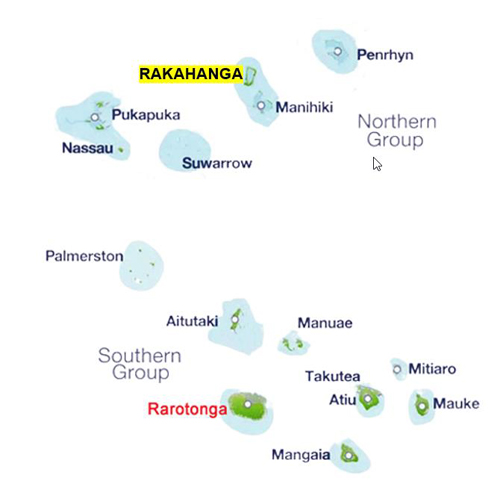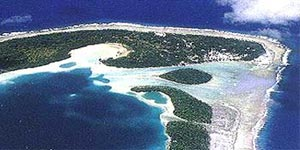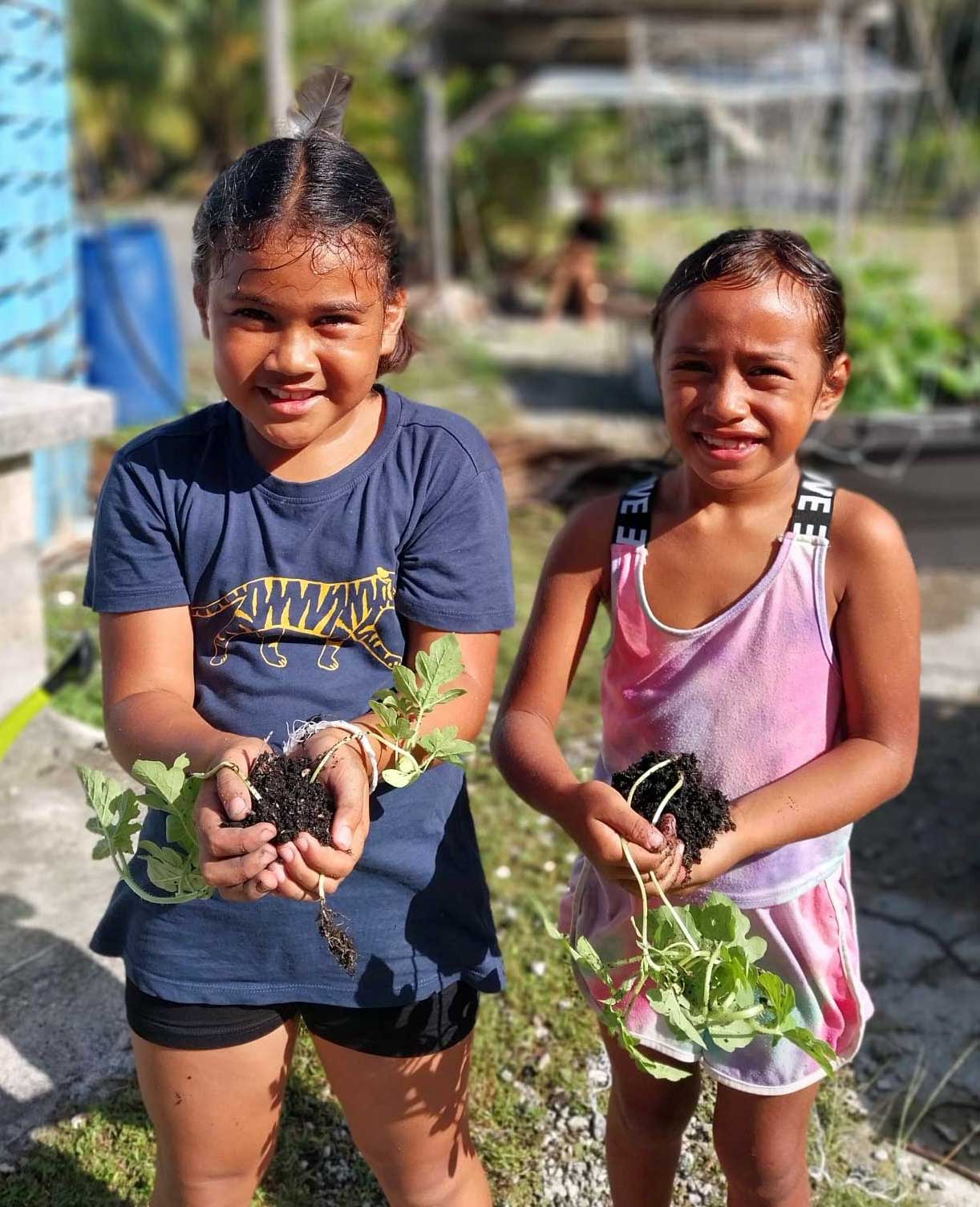RAKAHANGA
Where tomorrow never comes
Rarely visited by outsiders
"A community of love and kindness"
-
Believed to have been discovered by Portuguese navigator, Ferdinand Magellan in 1521
- First settled around 1200 AD, according to oral tradition
- In 1606 the Portuguese-born Spanish explorer,Pedro Fernandes de Quirós visited and, struck by the beauty of the islanders,named the atoll Gente Hermosa or the island of beautiful people.
- Like its nearest neighbour, Manihiki 42 kms south, it's so low lying (4.2 metres/13.7 ft above sea level at its highest point) it will get washed away if global warming causes sea levels to rise even a little
LOCATION: 1,248 kms/775 mls North West of Rarotonga
ACCESS: Very difficult. Local inter-island boat from Manihiki
POPULATION: 81
LAND AREA: 4.1 sq.kms/1.6 sq. mls

GETTING THERE
The only way to reach Rakahanga (if you haven't got a yacht or boat of your own) is via neighbouring Manihiki and hoping one of the islanders there will be visiting on a tiny inter-island boat. It's definitely not a journey for the faint hearted as seas can be difficult and the boat really is small
WHAT TO EXPECT
Tourism is non-existent but islanders are very welcoming. Journalist, Rachel Reeves paid a fleeting visit in 2015 and called it "a community that showers you with love and kindness". Here's how she described Rakahanga:
"This atoll ....has one crushed-coral road. It winds through fishponds and taro swamps; pigpens and palm trees; colourful houses with pareu for doors; a cemetery in the forest with tombs big as houses; dense thickets you can get lost in and white-sand beaches you can have all to yourself"
You can read the full report here
"If there are places left where a man can grow old
contentedly, it is on some such quiet, drowsy atoll, where today is
forever and tomorrow never comes; where men live and die, feast and
sorrow, while the wind and the waves play over the wet sands and
gleaming reefs"
Australian author, Julian Hillas (aka Dashwood) lived on Rakahanga during the 1940s. From his book, 'South Seas Paradise'
Photo: Kerry Harding

Rakahanga is traditionally called Tapuahua. There are two main islands and seven motus or islets in its 33m deep lagoon. On the east these are: Akaro, Motu Ngangle, Huananul, Motu Mahuta and Motu Okakara. On the southwest side the islet of Te Kainga ("the home") guards the widest passage into the lagoon. It's also the original dwelling place of the first residents.
Aerial pictures top and here courtesy of Ewan Smith, Air Rarotonga

The island is heavily reliant on imported supplies such as food, fuel and building materials, but cargo ships visit only two or three times a year. The main source of drinking water is rain water. Each household has some water storage capacity and there are also community water tanks. There is a hospital in Rakahanga with a nurse practitioner and also a public health office. The environment is largely untouched and is generally in a pristine state. The island is covered with thick lush coconut trees
Summary of extracts from a report by the Cook Islands National Environmental Service
A fresh new look...
but an uncertain outlook
Rakahanga was given a bright new look at the beginning of 2012. Dilapidated roofs were replaced with new ones made from different coloured steel and new water tanks have been installed. The school principal, Tuhe Pio said:
"The island's looking really beautiful. Now you stand back and instead of seeing rusty roofs you see a brand new village. People just look at their homes and feel very proud because they're nice."
But the transformation may have come too late. In recent years, the population of this remote island almost halved... results from the 2011 census showed that the number of residents was down from 141 in 2006 to just 77. After a small increase, the latest (2021) census shows a tiny decline again from 83 in 2016 to 81
SNAPSHOTS OF ISLAND LIFE
American author, Elliot Smith is one of a few outsiders to have written at length* about a visit to Rakahanga. Although that was back in 1994, little if anything has changed. He said the little settlement of Matara (also called Nivano) has a tiny wharf and boat landing. The CICC church, primary school, a couple of shops and some government offices sit among well-made houses in what he calls "this sleepy town". Tiny huts are erected over graves in the cemeteries, as is the custom on the island. And possessions of the deceased are placed in them to help them in the world beyond. Smith says the locals are more reserved than the neighbouring Manihikians, but most "warm up quickly".
*"Cook Islands Companion", 2nd edition, Copyright 1994 Elliot Smith. Pacific Publishing Co. Albany, California
NATURE'S BOUNTY
Unlike Manihiki and Penrhyn, the Rakahanga lagoon isn't suitable for pearls. Huge coconut crabs are its gems, and fishing is good on the outer reef. Large sea turtles abound there too. The critically endangered green turtle used to be a tasty treat for islanders but strenuous efforts are now made to protect nests and eggs and keep the beaches clean for them. Islanders are expert fishermen and each January a tuna fishing contest takes place. Boats return with 200 or more fish a day. Vegetation is abundant, large breadfruit trees line village paths and coconut palms and pandanus trees thriv
e
Turtle Photo: : Cook Islands Natural History and Heritage website/Gerald McCormack
A coarse dry taro called puraka or swamp taro is enjoyed by locals, but considered bland and starchy by foreigners. One European who lived on Rakahanga was clearly not impressed; this "recipe" is reproduced in his "Cook Islands Companion" mentioned above
"Cut up the puraka into small chunks about the size of a thumb. Put them in a pot of boiling water, along with a coral rock about as big as your hand, and cover the pot. Cook it all for three hours, adding some salt and pepper every hour or so. When the three hours are done, drain away the water, throw away the puraka and eat the rock. It will still have more flavour than the puraka!"

Young show the way on healthy eating
The 14 children in the island school are helping to promote healthy eating by planting their own vegetables. And the school principal, Maggie Purea-Taripo hopes Rakahanga's adults will follow their example. It's thanks to an initiative by the South Pacific Community (SPC) and the Cook Islands Ministry of Agriculture who've provided the island with three innovative raised bed cubes which use only a fraction of the water needed in conventional agriculture. The Ministry says the goal is "to improve nutrition leading to healthier and productive lives for our people". Photo: Cook Islands News
DISCOVER RAKAHANGA THROUGH THE EYES OF A RARE VISITOR
Kerry Harding described Rakahanga as "a beautiful little jewel to discover" when he had a rare opportunity to visit as a passenger on the tiny boat you see here
READ ALL ABOUT IT



